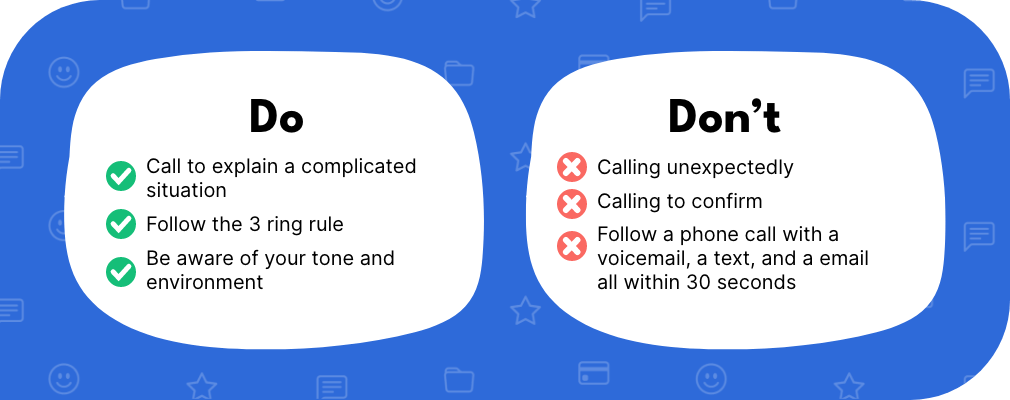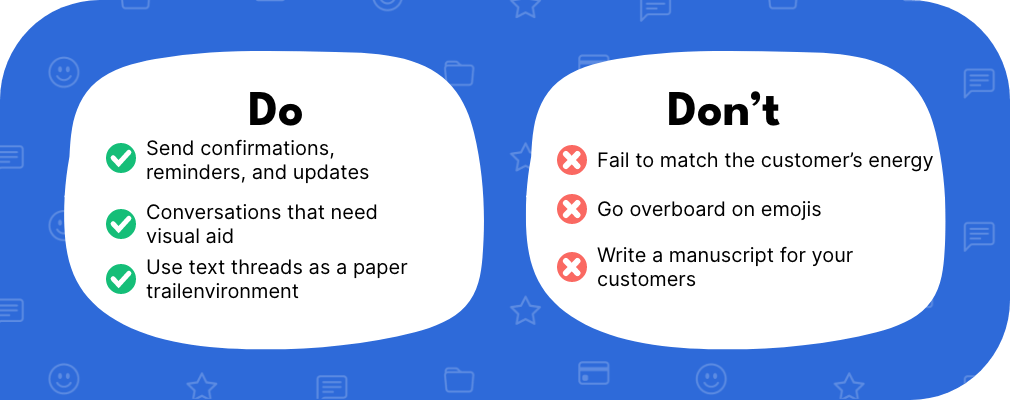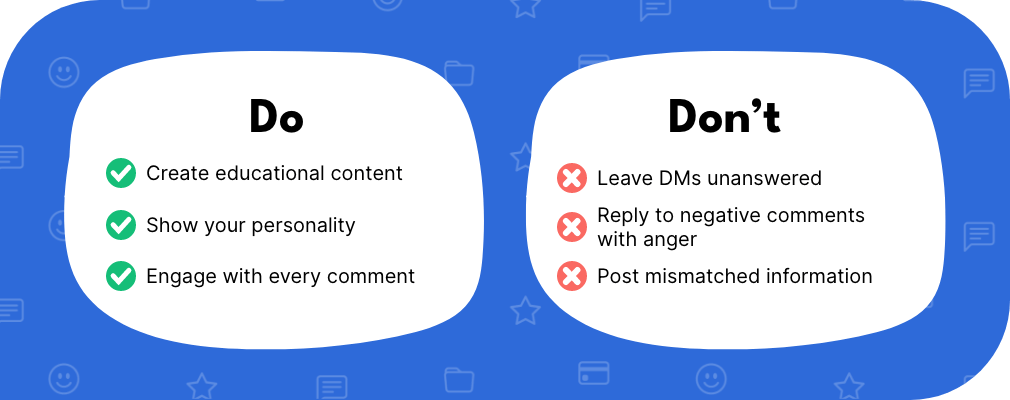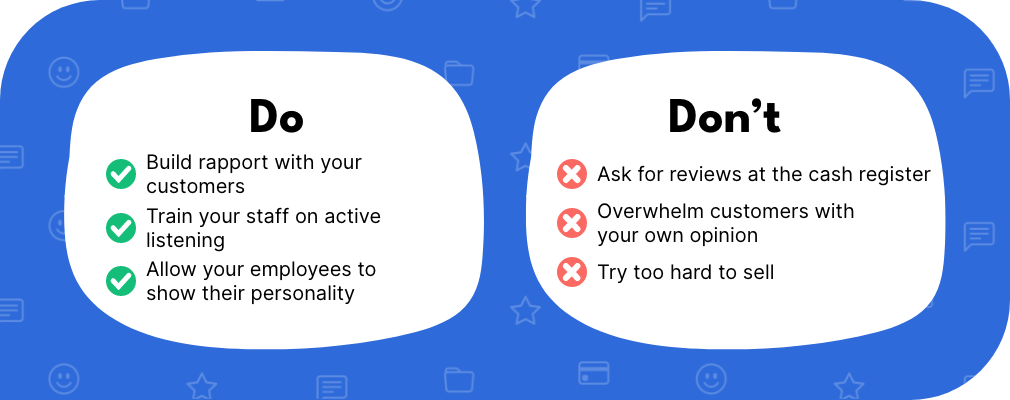Top 3 Do's and Don'ts of Customer Communication
Retailers today have access to countless tools and different avenues where they need to show up and keep up with customers.
However, it’s easy to lose sight of the bigger picture, so let’s take a step back and take a look at whether or not you are maximizing the tools already available to you.
Is email the best way to build relationships with your customers (where they can’t really respond to you), or are you missing out on a chance for authentic connection?
Is your staff constantly being interrupted with phone calls from customers asking about the status of a repair?
Let’s take a step back and look at the do’s and don’ts of all communication channels at your disposal: phone calls, text messages, email, social media, and in-person in your retail shop.
Phone Calls
Top 3 Do’s
#1 Call to explain a complicated situation
There are times when the most effective way to explain something to a customer is through a phone call.
Maybe a significant flaw was discovered while you were reworking a family heirloom or maybe the bike they dropped off a couple days ago needs more extensive repairs than initially anticipated.
Phone conversations become the better choice because they allow for more nuanced communication and in-depth discussions to take place. On the other hand, if you don’t schedule the phone call, the timing of that phone call can be less than ideal (don't get us wrong, we think texting is pretty awesome, but it might not be the best channel for certain situations).
#2 Follow the 3 ring rule
The rule of thumb is to try the customer again at a later time if they don’t pick up after 3 rings.
As mentioned before, if your call was scheduled, the chances of your phone call going unanswered would be much lower. Your other option would be to leave a voicemail, but data shows that only 1 out of every 5 customers will listen to a voicemail from an unknown number. Best way to go about it is to schedule the call, and avoid lengthy voicemails.
#3 Be aware of your tone and environment
While being able to establish a clear tone over the phone is a great thing on one hand, it can also backfire.
Multitasking and sounding distracted on a phone call gives the impression that you are disinterested – make sure you are calling from a quiet environment and that you are focused on the customer on the other end of the line.
Top 3 Don’ts
#1 Call unexpectedly
There’s a time and a place for phone calls, and while we think it is necessary to have some conversations over the phone, we highly recommend scheduling the phone call before.
An easy way to go about this is to text the customer to let them know what the conversation is about and asking them the right time to call while providing options, here’s an example:
“Hi Julia, we wanted to further discuss the item you dropped off for repair now that we have started some work, we can call you between 12-6, let us know what time works best”
#2 Call to confirm
Sometimes the saying ‘this meeting could have been an email’ also applies to phone calls. Sending confirmations and reminders are important for businesses and customers, but a phone call to confirm a tee time or to give an update on a repair is too time consuming for both parties.
#3 Follow a phone call with a voicemail, a text, and a email all within 30 seconds
Using every communication method at your disposal is a surefire way of creating frustration. If the first method of communication was unsuccessful, it’s most likely not the right time, and the customer will reach out when they can.
Not only will this cause confusion for the customer, as they won’t really know which method is the best one to get in touch with you, but it can also create an unnecessary sense of urgency.
Text Messaging
Top 3 Do’s
#1 Send confirmations, reminders, and updates
Sending text messages to share information that are significant enough to be shared but not important enough to warrant a full-fledged phone call is the best way to optimize your workflows.
Having your staff call customers for confirmations, reminders, or even updates about a repair is a waste of time on both sides. It even opens the door for customers calling in to get updates on their own which will interrupt your staff’s flow. Text messaging is an easy way to always keep customers informed and the best part is that you will always have a paper trail of every conversation.
#2 Conversations that need visual aid
Text messaging makes it easy to share images and videos. This might help them save a trip to your store and save time on attempting to describe the issue/situation verbally, or even worse having something sent to the store’s general email and clogging your inbox and making it difficult to keep things organized and on track.
This quote from Kimmi (General Manager @ Specialized Austin) says it all:
“It’s just so helpful for service, people can send us photos or videos, and just having that ability means they don't have to drag the bike into the shop. And we could just really quickly be like, oh, just push this lever forward. There, you just saved them a whole trip.”
#3 Use text threads as a paper trail
Once you implement business text messaging, you will realize that the paper trail you are able to have through your text thread with customers is priceless.
Not only will all conversations, images and videos be stored there, in case staff changes or a customer says they don’t recall a specific conversation, you are able to catch up and search through the text thread to make sure everyone is on the same page.
Top 3 Don’ts
#1 Fail to match the customer’s energy
It’s important to mirror your customer’s tone and the way they reach out to you. If a customer takes the time to write to you a long text message explaining a situation that needs your attention, it’s important to not send a short reply that doesn’t fully acknowledge their request.
Matching your customer’s energy will make them feel heard and understood, this way they will trust you and you are more likely to always end the conversation in a positive way.
An industry secret from Apple that always works are The 3 As: Acknowledge, Align, Assure. If you hit those 3 marks, you have a stellar response.
#2 Go overboard on emojis
Emojis are a great way to add tone to your text messages, when the time is right, they can add humor and allow you to show a little bit of personality.
Like most things, with great power comes great responsibility🕷️ , and it’s important to not overuse emojis. As we mentioned earlier, matching the customer’s energy is also important here, while the way you use emojis can be completely appropriate, if the customer doesn’t reciprocate, then it’s best to drop it.
We love how emojis are positioned in this interview:
“I don't want emojis to replace conversations, it should be a little accessory. They should set the tone.”
#3 Write a manuscript for your customers
If you find yourself typing an extremely long message to your customer (over 1000 characters long) then it’s your sign to turn that into an email or phone call. It’s easier for both parties, and your text message might get flagged by your carrier if it’s too lengthy.
Pro tip: If you choose to have this lengthy conversation on the phone, we always recommend texting the customer a summary, they will appreciate it and you will have a papertrail of what was discussed.
Top 3 Do’s
#1 Use emails for newsletters
Using emails for one to many communications where there is no need to give the customer the ability to reply back is one of the best ways to use email. Generally speaking, when customers sign up for your newsletter they do look forward to hearing from you, but it’s up to you to decide the content and the frequency.
#2 Use emails for product announcements
Product announcements are usually done in longer form content, and email is one of the best ways to do that. Long form content is best digested through email and you can give the customer multiple calls to action, such as sending them to your website or to video resources.
#3 Use email for mass outreach
Emails are a great way to send out company announcements and updates. These types of communication don’t need to feel personal, they are simply informative.
Top 3 Don’ts
#1 Bombard your customers with emails
You are guaranteed to upset your subscribers if you send too many emails. While it's true that those customers might not have been interested in the first place, there's a fine line between providing valuable content consistently and overdoing it to the extent that customers no longer want to hear from you.
#2 Send time sensitive emails
If you are expecting a time sensitive response from your customer, or if they are anxiously waiting to hear back from you, then email is not the way to go.
Emails are not read as frequently and they can also get filtered and tagged as spam as email providers get more and more sophisticated. To make sure a time sensitive matter is tended to, we encourage you to either text or call.
#3 Ask your employees to use their personal email on behalf of your business
There’s an array of reasons why you shouldn't do this. First and foremost, it is not in the best interest of your employees, asking them to use their personal email addresses for business purposes can blur the line between personal and professional boundaries. This can get tricky for both employer and employee and customer and employee relationships.
Not only that, but it can also compromise the security of your customer’s data, and if the employee quits then that means they get to keep sensitive company information.
Social Media
Top 3 Do’s
#1 Create educational content
Sometimes it’s easy to forget just how well you know your industry as business owners. Creating educational content for your followers doesn’t need to be complicated, creating how-to and informative content is the best way to create familiarity with your business and product.
#2 Show your personality
Social media is a playground where you can truly show your personality and although the rules (the algorithm) keeps changing, there are a couple types of content that you can never go wrong with.
Adding humor to your content and personifying your brand is one of the best ways to connect with your audience. If you don’t do that then most of your content will come off as sales-y.
Chime in on national holidays (instead of sending emails), or create posts that show your personality. A great exercise to do when brainstorming ideas for this type of content is to think of your brand as a person, what is their favorite movie? How do they like to celebrate holidays? This type of exercise will help you bring your brand to life.
#3 Engage with every comment
Whether the comment is positive or negative, it’s important to engage with customers. Not only will they feel seen, it also shows others that you are active and is a prime example of how you do customer service.
Top 3 Don’ts
#1 Leave DMs unanswered
Ignoring inquiries from followers will not only create frustration but might make customers or potential customers not want to do business with you. Especially if you are active on social media and continue to ignore their message.
The best way to go about this is to have a routine where a member of your staff is responsible for answering all direct messages (DMs), and you can even keep all communication in one place through Ikeono’s inbox where you can keep track of DMs, web chat inquiries, and text messages all in one place.
#2 Reply to negative comments with anger
It is especially important to keep your composure when addressing negative comments, not taking it personally is the way to go – offer the customer to settle things in a more private manner, either through direct messaging on, email or text message. Nobody wins if both parties approach the situation with anger.
#3 Post mismatched information
Posting mismatched information can look something like having a different name, address, phone number, or operating hours on your Google My Business, your website, or social media.
Not only will this negatively impact your local SEO (read more about it here), but it might make a customer change their mind about visiting your store or send unnecessary and repetitive questions your way to clarify.
In-Person
Top 3 Do’s
#1 Build rapport with your customers
Take advantage of your customer’s physical presence in your store and make sure to build a relationship with them!
In a world where the product can generally be found from multiple businesses, the best way to shine is to create long lasting relationships.
#2 Train your staff on active listening
What does active listening look like?
It looks a little like what we discussed earlier about mirroring the customer’s energy. It’s important to avoid ‘template matching’ and instead really listen to the customer’s questions and needs before jumping to a conclusion.
#3 Allow your employees to show their personality
Providing sales training and educational information sessions for your employees are great onboarding tools, however it’s important to give creative freedom to the way they pitch and relate with customers.
The technical details and features of your products are all available online, in fact 81% of people walking into your store have researched what they are looking for. This means that your employees can focus on selling with personality and spend time creating rapport with customers.
Top 3 Don’ts
#1 Ask for reviews at the cash register
One of the best parts of retail and in-person interactions with customers is the way you and staff can build personal relationships in a way that would not be possible otherwise.
Conversations are organic and you can truly make customers feel extra special, but when you ask your staff to ask for reviews at the end of that interaction, it can feel scripted and transactional. Neither party enjoys this part, and that customer will most likely forget to write you a review no matter how good the service was.
#2 Overwhelm customers with your own opinion
The educational aspect that you and your team can bring to the table during in-store interactions is unmatched. It feels so different from educational social media content, or any other avenue you choose.
While in-person, it’s so easy to let your own experience and opinion take over how you educate the customer and guide their decision. Remember that while you have been in the industry for a long time, the customer in front of you has a whole different perspective and most likely different needs. It’s best to focus on what would suit them best regardless of your own experience.
#3 Try too hard to sell
There’s no denying that retail has changed over the last decade or so with the introduction of eCommerce, you might have been in situations where you realized the customer is most likely not going to make a purchase in-store. They are probably there to see what the product looks and feels like, and they might need more time to research which will lead them to make the purchase online.
In those situations, it’s best to read the signs and instead of trying to sell to the customer, position yourself as an expert and highlight the different benefits and services they can get by coming back to you at your retail store.
Carrier Pigeon
Top 3 Do’s
#1 Provide your pigeons with stylish little carrier bags so that arrive to your customers in style and on brand
Just kidding… at the end of the day, whatever method of communication your customer prefers is the one you should go with 😉!







